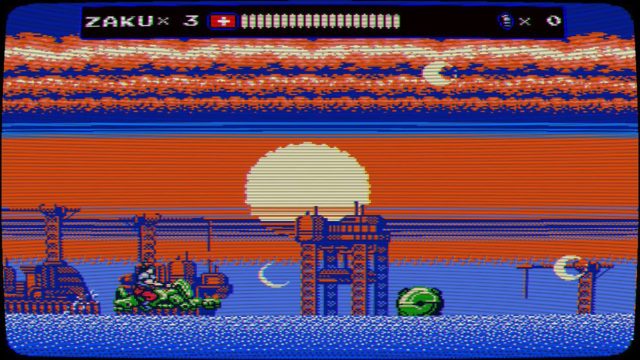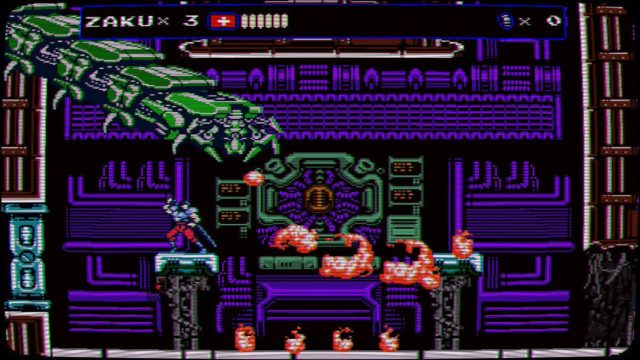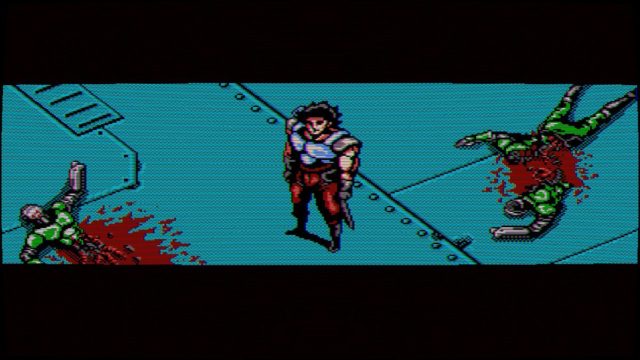Great gameplay; gorgeous visuals; solid soundtrack
Difficulty level and violent storyline will turn off some players; Joy-Con thumb stick can cause some accuracy issues
In the heyday of the NES, gamers were treated to a number of truly challenging titles. Games like Ninja Gaiden and Contra forced players to die over and over again to find out the exact right way to challenge each level, placing a huge emphasis on memory and reflex. Oniken: Unstoppable Edition follows a similar path, offering an old-school difficulty level that matches its old-school aesthetic.
In Oniken, players take on the role of Zeko, a mercenary hired by a rebellion to take out the titular machine army. The game’s story is dripping in 80s cheese, but the tale is told masterfully, with gorgeous cutscenes. Those cutscenes, and the gameplay itself, are filled with as much over-the-top violence as the developers could squeeze out of the game’s retro graphics; Zeko’s sword decapitates foes, cleaves opponents in half and leaves a swath of dead enemies in his path. While the gameplay is a clear love letter to video games from the Reagan era, the game’s story feels like an homage to that decade’s comics. Oniken’s villains feel like they’ve been culled from the pages of X-Men, Daredevil and GI Joe, and while this might seem like a bizarre mixture, it perfectly fits the game’s tone and style.
Oniken’s main game only has six levels, but each stage is broken up into multiple segments. While not always the case, sometimes the breakdown of segments reflects a change in gameplay: some center primarily on platforming, while others might make combat the focus. In these stages, Zeko solely has two weapons to work with: a sword and grenades. The game also has a handful of segments where Zeko travels on vehicles, such as jet skis or snowmobiles. That gameplay variety adds to the challenge, while also keeping things from ever becoming too monotonous.

Players begin each stage with three lives. When each segment of the stage ends, Zeko’s health bar is refilled, giving players a little extra breathing room. Once all three lives are spent, however, it’s back to the stage’s start, no matter which segment you left off at. While the repetition of completed segments can cause some frustration, it also brings with it an extra incentive for players to continue to perform better on each subsequent attempt. After repeated attempts, I found my ability to get to later segments with all lives intact easier and easier. Besting each of the game’s levels comes down to memorizing enemy locations, practicing patience and tempering frustration. The approach almost feels akin to a rhythm game, since so much of the gameplay comes down to timing. The blessing in this approach is that it means Oniken’s stiff difficulty level never evokes the more unfair action games of the era it’s based upon.
None of this would work if Oniken’s controls felt off and, for the most part, Zeko handles very well, whether you’re platforming, or lobbing grenades at the robot polar bear that’s in hot pursuit of your snowmobile. That said, there were some occasions where a D-Pad felt like it would have been a lot more accurate than the Joy-Con’s left thumb stick. This became most noticeable when I’d need to crouch quickly to avoid an attack, or when pressing up and ‘X’ to lob grenades. Thankfully, there are workarounds to the problem, such as the Classic Controller, or Hori’s D-Pad Controller. I completed the game predominantly in handheld mode with the traditional Joy-Con without too much frustration, but old-school purists will definitely want to take those other options into consideration.

Six levels might not sound like all that much, but the main game should take players in the ballpark of four to five hours, depending on their level of skill. Finishing the game unlocks a handful of new options, including Boss Rush and Hardcore modes, giving players more reason to keep playing. More exciting, however, is a bonus seventh level where players take on the role of Jenny Connor, a supporting character from the main game. Unlike Zeko, Jenny has a gun with unlimited fire power, giving her level a much different feel from the rest of the game.
Any game that tasks its players with frequently revisiting stages needs a soundtrack that won’t grate on the nerves. Thankfully, Oniken’s chiptunes never get old. The game has a number of great tracks that perfectly fit with the game’s approach, and they’ll stick with players long after the Switch has been turned off.

After every punishing stage I finished in Oniken, I felt completely drained; my nerves shot. I would force myself to take a break, jumping into a less emotionally taxing game before heading back. That feeling clearly won’t be for everyone and the game’s over-the-top violence will definitely scare off some gamers. However, the personal satisfaction that comes from finishing each of the game’s stages cannot be overstated. Oniken: Unstoppable Edition is meant for a certain kind of NES fan; those that revel in that sort of old-school challenge will find little else like it on Switch.
Nintendojo was provided a copy of this game for review by a third party, though that does not affect our recommendation. For every review, Nintendojo uses a standard criteria.




 ShareThis
ShareThis





